Customizing soft plastic baits means changing their look, feel, and smell to catch more fish. It helps you make lures that work best for your local waters and target fish.
Quick Summary: Customizing Soft Plastic Baits
- You learn how to make your fishing lures unique.
- You discover how to pick the right materials and colors.
- You understand how to improve your fishing success.
- You get tips for testing your custom baits.
Estimated reading time: 7 minutes
Do you want to catch more fish? Many anglers are now customizing soft plastic baits. This lets you make lures that are perfect for your fishing spot. It can truly boost your catch rates and make fishing even more enjoyable.
What Are Custom Soft Plastic Baits?
Soft plastic baits are popular fishing lures. They feel like real food to fish. You can change these baits to make them special. This means picking their shape, color, feel, smell, and how they move in the water.
You can make your own baits from a liquid material called plastisol. You can add colors, scents, and special effects. This helps you create lures that look and act just right.

Making your own baits lets you:
- Choose molds: Pick shapes like worms, craws, or swimbaits.
- Change colors: Use dyes and pigments. You can even add glow or color-changing effects.
- Adjust feel: Make baits softer or harder for different fish and water.
- Add scents: Use smells that attract fish.
- Control float: Make baits float or sink as you need.
Many stores in Canada sell everything you need. This includes the base plastisol, colors, and powders. You can find materials for texture, floating, and glow effects.
Why Customize Your Baits?
More and more anglers are making their own baits. This helps them stand out and catch more fish. Online videos show how easy it is to start this hobby. Many molds and materials are easy to find.
Affiliate Disclaimer: We may earn a commission from purchases made through the links on this page without any addiitonal costs for you. Thank you for supporting our website ! Appreciated 👍
New store-bought soft plastics also show this trend. They have very real colors and strong materials. This shows that anglers want lures that work better and can be changed.
Canadian stores see more people buying bait-making supplies. These buyers range from casual anglers to pro guides. They all want special baits for their fishing spots.
- Layer Colors: Pour different colored plastisol layers into the mold. This creates unique, eye-catching patterns that fish haven’t seen before.
- Add Salt: Mix fine salt into your plastisol for a slower sink rate and a different feel. This can make fish hold on longer after a bite.
- Glow in the Dark: Use glow powders for night fishing or deep, dark waters. Charge them with a light for maximum effect.
- Recycle Old Baits: Melt down old, damaged soft plastic baits. Filter out dirt, then re-color and re-pour them. This saves money and reduces waste.
How to Customize Soft Plastic Baits: A Simple Guide
Making your own baits is a fun process. Here are the steps to get great results.
1. Pick the Right Mold
Start with a mold that matches a bait you already like. This could be a creature, craw, worm, or swimbait. There are many molds available today. Finding one like your favorite bait helps you feel confident. It also lets you try new colors with a shape you know works.
2. Get Your Materials Ready
You will need a few main items. You can find them easily from Canadian suppliers.
- Plastisol: This is the main liquid for your bait. It comes in different types. Finesse is softer for small fish. Standard is harder for bass and pike.
- Colors: Use pigments and dyes to color your baits. You can get bright, pearl, or color-changing powders. Mix them for cool looks.
- Glitter and Powders: Add glitter or glow powders to make baits more eye-catching.
- Scents: Put in smells that attract fish.
- Floating or Sinking Powders: Use these to make your bait float or sink. This helps with different fishing styles.
3. Melt and Mix
Heat the plastisol in a microwave-safe cup. Make sure it melts completely. Then, add your colors, glitter, and scent. Stir everything well. If you want baits with many colors or swirls, you can layer different colored plastics before pouring.
4. Pour or Inject the Mold
Pour the melted plastisol into your mold. For baits with many small details, use a special injector. This helps avoid air bubbles. For simpler shapes, just pour the liquid in.
5. Cool and Finish
Let your bait cool down. It needs to harden before you take it out of the mold. Some baits might need extra steps. You might trim off extra plastic. You could also paint small details or add scent gel.
6. Test and Improve
You must test your new baits when you go fishing. See how fish react. Change the color, scent, or hardness based on what you see. Keep trying new things. This helps you make very effective custom baits for your area.
Bait Color Planner
New Trends in Custom Soft Plastic Baits

Several new ideas are shaping how people make custom baits.
- Real-Looking Colors: New ways of printing and painting make baits look very real. This helps them attract fish.
- Stronger Baits: New materials make baits tougher. They last longer against rocks, fish teeth, and many uses. This is good for Canadian waters where fish can be aggressive.
- Weedless and Slow-Sink: Special designs help baits move through weeds easily. Floating or sinking formulas give you more control. This is great for fishing near underwater plants.
- Eco-Friendly Materials: People care more about the environment. So, new bait formulas are safer for nature.
- Community Learning: Online videos and groups help new bait makers learn. They can share tips and ideas. You can find many helpful tutorials on YouTube.
Customizing Soft Plastic Baits for Canada
Canada has many different places to fish. This offers special chances for custom bait makers.
- Many Fish Types: Canada has bass, pike, muskie, walleye, and trout. Each fish likes different colors, sizes, and bait actions.
- Water Conditions: Lakes and rivers across Canada vary a lot. Water can be clear or cloudy, warm or cold. You need different baits for different conditions.
- Easy to Find Supplies: Canadian stores like CMA Outdoors and Great Canadian Fishing Store sell many bait-making items. This makes it simple to get what you need.
Success Stories
Many people share their journey from new to expert bait makers. They show the steps, mistakes, and good ideas they learned. These stories often suggest starting with baits you already like. Then, slowly try new shapes and colors as you get better. You can find many such stories on YouTube.
Canadian suppliers say the best custom bait makers pay attention to local fish. They watch what fish do and how seasons change. By copying good store-bought baits and then changing them, anglers make unique lures. These often catch more fish than regular ones.
Challenges and Solutions
Even with many good points, customizing baits has some challenges.
- Learning: New makers might find mixing or heating hard. But online videos and groups help a lot. Many YouTube channels offer great guides.
- Costs: Starting costs are low. But if you make many baits, you might need to buy more molds or tools. Buying in bulk or sharing gear can save money.
- Rules: Some areas have rules about bait use. Using eco-friendly materials helps protect the environment.
Future of Custom Baits
The future for customizing soft plastic baits in Canada looks good. There will be new materials, designs, and easier ways to make them. As more anglers try making their own baits, we might see:
- Better Tools: Easier and more exact tools for making molds and injecting baits.
- Green Materials: More use of materials that break down naturally and are better for nature.
- More Learning: More online help and local meetings to share ideas and tips.
Expert Tips for Beginners
- Start Simple: Pick a mold like a bait you already use. Try different colors and scents.
- Buy Good Supplies: Quality plastisol and colors make your baits work better.
- Learn from Others: Use YouTube, online groups, and local clubs. This helps you learn faster.
- Test Your Baits: The best way to make your baits better is to use them. Watch how fish react.
- Write Down Your Recipes: Keep notes on what you used and how it worked. This helps you make your best baits again.
In-depth discussion on the topic:
Listen to our expert discussion
Your Questions About Customizing Soft Plastic Baits Answered (Simply)
What is the main material used for soft plastic baits?
Is it hard to start making my own fishing baits?
Where can I buy supplies for customizing soft plastic baits in Canada?
How do I make my custom baits float or sink?
Can I add scent to my homemade soft plastic baits?
What are “photo-realistic colors” in baits?
Why is testing my custom baits important?




